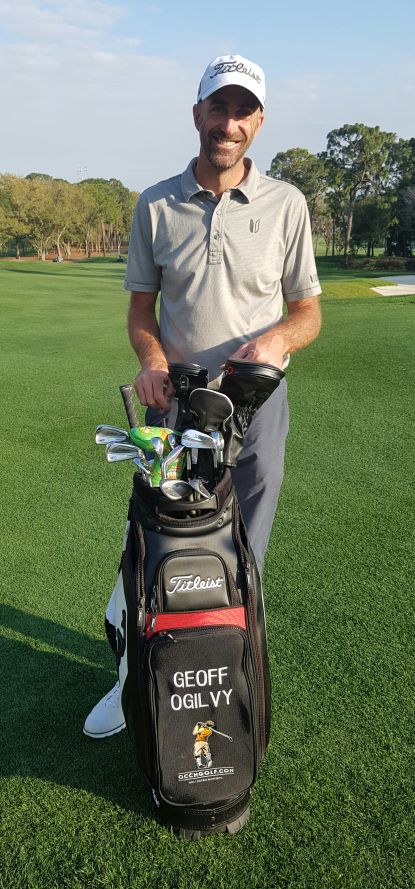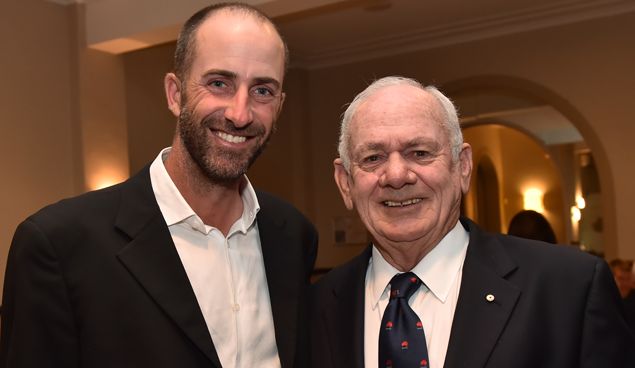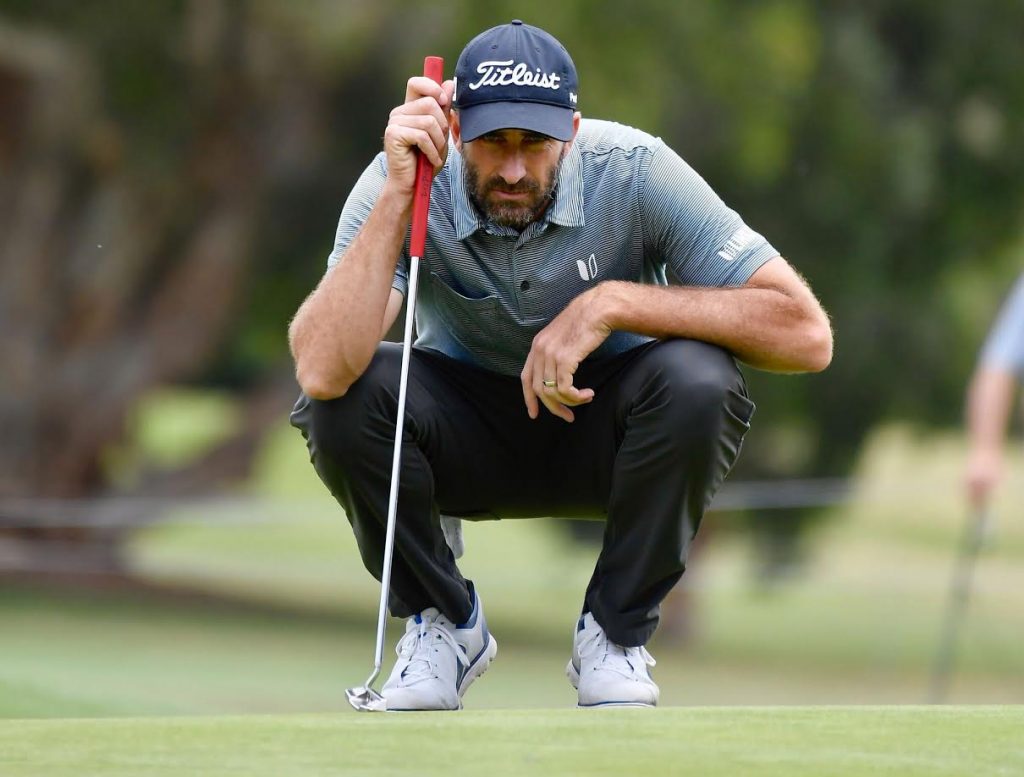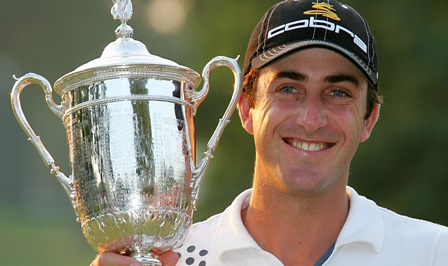Fort Worth, TX …
When a long-time fan wondered, “Geoff Ogilvy is such a fine golfer, and he has one of the best brains in golf. Wonder why he has not played to his potential in recent years?”
So, it was time to ask him “As you’re known to be a thinker, what are you doing to bump up your game to the next level given that you’re probably interested in all things golf and know a lot about it?”
The reply was, “I try to learn as much as I can really, like trial and error, cause and effect, if I do this or that what happens technically or mentally or strategically, kind of like a scientific approach. The only flaw is I do not wait too long, if it does not work quickly I try something else.”
 Another “experiment” he likes to perform is to study patterns in other master-golfers’ games – both current and past – and then try to objectively assess his own movements based on the common traits of the greats. He is trying to recreate the times when he played his best golf – when things happened instinctively – which is what kids tend to do. He feels he is getting close and has learned a lot, and continues to learn a lot every day, from understanding the cause-and-effect of his own game better.
Another “experiment” he likes to perform is to study patterns in other master-golfers’ games – both current and past – and then try to objectively assess his own movements based on the common traits of the greats. He is trying to recreate the times when he played his best golf – when things happened instinctively – which is what kids tend to do. He feels he is getting close and has learned a lot, and continues to learn a lot every day, from understanding the cause-and-effect of his own game better.
The next step in understanding Geoff Ogilvy’s performance patterns was to conduct a scientific analysis of his game to understand what is going on, based on a rudimentary physical analysis and following him for 9 holes during the #ATTByronNelson.
Step one, naturally, was to study his PGA TOUR ShotLink statistics.
In 2017, Ogilvy has had 35 of his Tour rounds measured and his numbers are (with rank in parentheses): driving distance 283 yards (163) and club speed 112 miles per hour (130); driving accuracy 62% (98); greens in regulation 67% (75 – the best of all his ranks); average number of birdies per round 3 (191). He hit left rough 12% of the time and right 16%, showing that his misses can go both ways. Finally his average number of putts per round was 30 (166). So, the fan was right, he is not currently performing as well as he might. Is it physical or mental? Well, with “one of the best minds in golf”, it is surely more likely to be physical, and below is some information on how a player should be assessed to give him the best possible advice.
His body-type (ectomorph) is tall, lanky and wiry, which is truly ideal for golf as his limbs form long levers. The next items to assess should be gait (for how comfortably he can walk hilly golf courses for about 5 hours each time) and, most importantly, posture. Posture can often indicate why a golfer swings in a particular manner, and is sometimes congenital and cannot be altered. However, if it is a result of bashing hundreds of balls for years, there are often physiotherapy- and chiropractic-related solutions available. Even from a distance it is obvious that Ogilvy has a slightly stiffer left shoulder-girdle-arm complex; a right shoulder that sits forward (towards the target line) of the left, especially when in golf posture; and overall a tight, rounded back (mild kyphosis of the thoracic area of the spine).
The next item to be assessed should be his putting.
Even though he hits a decent 67% of greens, he only makes an average of 3 birdies per round and also usually makes 30 putts per round. While many aspects could affect his putting such as the distance he is able to put his ball from the hole with his approach shots, or the quality of his putter, the putting stroke itself is a key element too. His right shoulder is forward of his left during the set-up of his putting stroke too. So, his right arm is able to move freely and well allowing a straight-down-the-line stroke. However, his tight left shoulder elevates at an awkward angle during his follow-through and he pulls his left arm “inward” or away from the target line so that his left arm cannot move as smoothly as the right one as the club contacts, then moves past, the ball. This movement can result in jerky putts, especially under pressure when muscles become tighter still!

Austalia’s only two U.S. Open champions together for a first time at the 2015 Australian Golf Writers Australia annual dinner.
He might just be intentionally pulling his left arm “in” during the through movement (it used to be quite the fashion some years ago), as that is what he does with his chips shots too. His chip shot has a quick wrist-break which steepens the club shaft, and is accompanied by a raising of the right shoulder, followed by a pulling “in” of the arms in the downswing. This combination of a steep, short backswing and a very flat, pulling “in” downswing, can occasionally cause the club to make a glancing blow on the ball – resulting in a skull, which Ogilvy actually had, on hole 16!
Finally, what about his full-swing?
A respected golf journalist who writes for one of the leading magazines and has even caddied for Ogilvy in recent weeks said “I love his swing, it’s like a wheel turning”. The rotary swing, while looking good, is not suitable for golf, as golf is a double-handed (both hands on club) game. As soon as one shoulder moves forwards, towards the ball, the opposite elbow bends. This might be fine for a movement such as baseball batting, where the object to be connected is merely hip-high, but in golf, the need is for the arms to both be maximally straight as they arrive at the ball, and ideally fairly straight for some time on either side of it! An overly rotating backswing has many more pitfalls, especially one such as Ogilvy’s where the shoulders and upper chest rotate far more than the trunk and pelvis. In addition, his left knee and shoulder lower considerably during the backswing, while his right shoulder girdle is extremely pulled back and raised (retracted and elevated), with the right arm being pulled very close into the body at the top of the backswing (internally rotated). From this position it is very difficult to drop the arms down to the ground, and this golfer is forced to make some dangerous downswing compensations to allow his arms to straighten so the club can connect with a ball on the ground. As his tight right shoulder cannot easily drop back so that the club can arrive from the “inside”, he thrusts his pelvis forwards, to try to try to force the right arm to fall back inside, and also to straighten. Such a compensation means that the club will not always connect the ground in the same manner each time, because the downswing happens within a very short period of time. The inevitable result? Inconsistency.
What are the solutions?
One he has already figured out. In an interview some years ago he mentioned he had switched from hitting 500 balls on a driving range to practicing more and this idea fits in very well with modern motor learning theory. Research has shown that the human brain is better able to figure out how to move in different circumstances (“constraints”) with more experience in a larger variety of those circumstances, such as wind condition or lie of the ball (environmental); changing from one club to another for different distances (task); and one’s mental frame of mind or amount of sleep from the night before (organismic).
The other? To do some simple daily exercises and acquire some top-quality long-term physiotherapy or chiropractic treatment for the tight, rounded back. And the third and perhaps most useful and immediate solution would be to use a swing which does not have excessive and exclusive upper-spine rotation. Such a swing should be able to place his right shoulder in a wide, externally rotated position at the top, so it can easily and effortlessly get the club into good position at impact. Put the three elements together, along with a calm, focused mind, and Ogilvy can surely have more consistency in his performance, not relying on timing and “luck” to play well. And on the subject of luck. A book Ogilvy read and really loved is The Alchemist, a story whose main message is, “When a person really desires something, all the universe conspires to help that person to realize his dream.”
About Kiran Kanwar
MS: Nutrition and Human Performance; Sports Science and Rehabilitation
Class A: The LPGA (T&CP)
The PGA (GB&I, Advanced Professional) from 1995-2016
The PGA of India (Board Member)
National Golf Academy of India (Teaching Staff)
Columnist: My Avid Golfer Magazine
Member: Golf Writers’ Association of America
Website: www.mgs.golf





